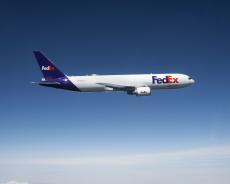FedEx Express has introduced its new 767-300 freighter, scheduled for operation this fall, aspart of the company’s aircraft fleet modernisation strategy for more efficient, lower-emission
freighters.The new cargo jet joins the Boeing freighters 757 and 777 previously introduced by FedEx.
“This is yet another positive step in our company’s fleet modernisation strategy to add moreefficient, lower emission aircraft to our global fleet,” David J. Bronczek, president and chiefexecutive officer of FedEx Express, said. “The operational efficiencies of the 767 will mirrorthose of the other new aircraft types we continue to introduce, and will provide the highlyreliable service our customers demand.”
With a maximum gross payload capacity of 127,100 pounds, the medium wide-body 767 freighter hasa flight range of 2,922 nautical miles (3,362 statute miles). The freighter is approximately 30%more fuel efficient, with unit operating costs being more than 20% lower than the MD10 aircraft itwill replace. Another advantage is that it can share parts, tooling and flight simulators withFedEx 757 freighters.
The initial 767 plane was delivered to FedEx from Boeing last month and is undergoing thecertification process required to begin service. FedEx has ordered 50 freighters of this type to bedelivered by the end of the company’s fiscal year 2019.
The FedEx 767 freighter is also featuring a new “efficient container” or Unit Load Device usedto hold individual packages on the aircraft. It is lighter and its construction includes morerecycled materials than the company’s previous containers.
Under its aircraft fleet modernisation programme, FedEx began upgrading its fleet in 2007 withthe addition of 757 freighters to replace the 727s. The final 727 freighter was retired in June. In2009, the company introduced the 777 plane, the world’s largest twin-engine cargo freighter with anon-stop flight range of 5,800 nautical miles (6,675 statute miles) and a cargo capacity of 178,000pounds.












